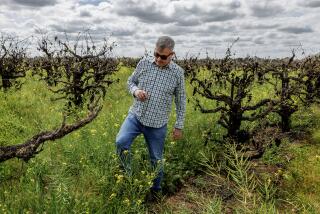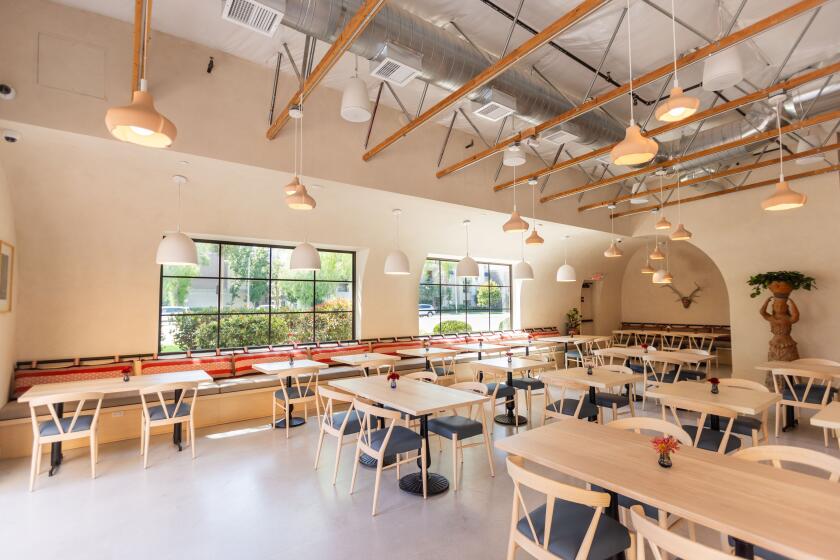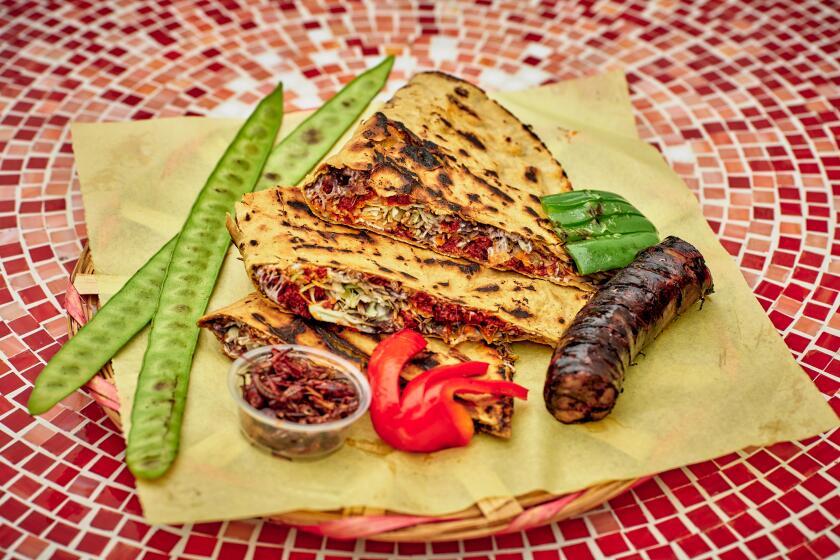Zinfandel Sees Red . . . Again
If the roughness and relative mediocrity of $10 Cabernet bothers you, perhaps you should consider red Zinfandel. It generally offers more drinkability at an earlier age, it’s better than ever and prices remain about $10 a bottle.
Zinfandel, whose reputation was stained by the rough, harsh, high-alcohol brutes of the mid-’70s, has traversed a rocky road. Consumers grew so weary of the astringency and dry-Port qualities of those wines that the variety was actually threatened with extinction. Only the faddishness of White Zinfandel, which grew in sales to more than 11 million cases in 1990, saved the vines from being ripped out by frustrated growers.
But some producers have always made stylish red Zinfandel. One of the style leaders was Sutter Home, the Napa Valley winery that began the White Zinfandel craze. The reason for its success? The high quality of the fruit it used.
It all goes back to one particular dinner in 1967. Sutter Home president Bob Trinchero was dining at the home of Sacramento wine merchant Darrell Corti, and Corti served him the 1965 Harbor Winery Zinfandel, made from grapes grown by Ken Deaver in Amador County.
Deaver’s 80-year-old vines produced a robust, fleshy wine with marvelous spice and a dense, rich blackberry aroma. Impressed, Trinchero began buying grapes from Deaver, and Sutter Home’s Zinfandel became a wonder of spice and berry-like fruit, with depth and harmonies permitting it to be consumed early or aged late.
Sutter Home recently staged a tasting of every vintage of its Amador Zinfandel, including its last bottle of the 1968. Amazingly, the wines from the early years were still alive.
Trinchero said the old standard to which he had held the wine was great for wine lovers, but the wines were a little tannic and astringent. “Restaurateurs liked the wines, but they said they couldn’t age them long enough to become soft,” said Trinchero. “They asked me to make the wine softer and more approachable.”
So in 1978, Sutter Home blended grapes from other regions into its Zinfandel and took the Amador designation off the label. “Sales doubled,” said Trinchero, but he added ruefully, “The wine just wasn’t as good. By 1980, the old Zin lovers were starting to throw rocks at me.”
An in-house debate arose: What to do? Experiments began in 1980 to make a Reserve Zinfandel blending the old and new vines, but it wasn’t until 1983, when new oak puncheons were brought in to age the wine, that Sutter Home began a slow transition back to the quality Zinfandel for which it once had gained fame.
The 1984 Sutter Home was a classic, deeply complex with a trace of the jam quality so often found in Amador fruit. The 1985 was even better, loaded with fruit.
Just released, the 1987 Reserve ($9.50) is a jewel, offering violets and a trace of jam. It should give those old Zin lovers something to recall, in case they’ve drunk up their stash of the 1970 or 1972.
(A note for those who may have a bottle of the 1971 Sutter Home Zinfandel: There were two bottlings. If your bottle has a white capsule, beware; it probably is dull and lifeless. Bottles with the black capsule are still excellent.)
Tasting Notes
Tasting a range of Zinfandels these days is difficult because so many of the wines are so good, and style differences become the point of differentiation. In doing the evaluation of these 20 bottles I excluded the 1988 Nalle, 1988 Haywood and 1987 Terraces, all of which were rated as among the best wines I’ve had in the last few years (all were previously recommended).
Moreover, I excluded some wines that are in short supply. In general, Mendocino County wines fared best, with Kendall-Jackson’s Dupratt worth the high price. The next day, I tasted a superb 1988 Frog’s Leap Zinfandel ($11.50) that I suspect would have scored as well as the Kendall-Jackson. It was magnificent.
1. 1987 Kendall-Jackson Dupratt Vineyard ($20)--Explosive blackberry-jam fruit, with a spice component similar to faint black pepper; long, toasty finish. Wine maker Jed Steele also has three other excellent Zinfandels on the market, including two (Mariah and Ciapusci) in very short supply as well as a more available release (see below).
2. 1988 Ridge Geyserville ($14)--Stunningly complex wine with broad spice and berry notes, a hint of chocolate and cedar and a “sweet” complexity, making the wine drinkable today and worth cellaring too. A classic wine.
3. 1989 Quivira, Dry Creek ($13)--To be released April 1: Lighter-styled than past vintages, but seductively elegant with warm cherry/raspberry notes and a delicate toasty component, little astringency and a complex finish. Try it with salmon.
4. 1988 Shenandoah Special Reserve, Amador ($8.50)--Amador spice (like strawberry jam), lighter in texture than some, but with ample taste of plums and berries. Some oak notes recede into the background with aeration. Good value.
5. 1986 Fetzer Reserve ($12.50)--Complex berry and toast/cedary notes, and rich in the mouth with a complex finish.
6. 1988 Dry Creek “Old Vines” ($10)--A bigger, richer-styled wine with very ripe, cassis notes; fairly deep taste, but a touch coarse. A powerful wine for hearty stews.
7. 1988 J. Pedroncelli ($7)--Mild spice with berry and cedar; softer, easy to drink.
8. 1988 Ridge Lytton Springs ($12)--Delicate dill and eucalyptus aroma (with a faint trace of iodine in the initial whiff); open up with air to show dense, rich fruit. A slightly short finish dropped its score.
9. 1989 Kendall-Jackson Vintner’s Reserve, California ($11)--Slightly jammy fruit with a “sweetish” aroma, but a little simple and soft.
10. 1988 Ridge Sonoma ($8)--A “sour cherry” and dill aroma are interesting, but with air the wine shows more depth and richness. With 12% Carignane and 8% Petite Sirah, the wine should be better in another year or two. Good value.
11. 1988 Boeger, El Dorado “Walker Vineyard” ($8.50)--Elegantly fruity, with a toasty/spicy aroma and soft, appealing fruit in the mouth. A lovely, drinkable effort.
12. 1987 Grgich Hills, Sonoma ($12)--Dusty, slightly peppery, with fruit that needed time to open up. The wine was a bit simple, though enjoyable. (It has scored better in other tastings.)
13. 1987 Fritz, Dry Creek ($8.50)--Bright fruit, invitingly raspberryish notes; dry, not very tannic, but short finish.
Others evaluated: 1985 Traulsen ($12); 1988 Hidden Cellars “Pacini Vineyard” ($10); 1986 Inglenook ($8.50); 1989 Charles Krug ($8); 1988 Domaine Breton ($8); 1987 Chateau Montelena ($12); 1988 DeMoor ($10).
Overall, the tasting showed the high quality of the Zinfandels available in California today. Most of the wines, even those at the lower end of the list, were enjoyable.
Wine of the Week
1987 Domaine Michel Briday Rully, Champ Clou ($17)-- The Rully region of Burgundy is not well known in the United States, but it makes red wines that are soft and fruity, with more delicacy than the wines of other Burgundy regions. This elegant wine offers excellent cherry-like fruit and a generous mouth feel. With the price of French red Burgundy climbing to ludicrous heights, this offering from importer Neil Rosenthal is an excellent value.
More to Read
Eat your way across L.A.
Get our weekly Tasting Notes newsletter for reviews, news and more.
You may occasionally receive promotional content from the Los Angeles Times.










